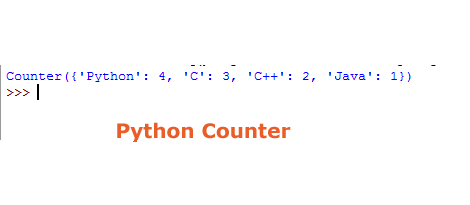Important points about the Counter:
- The counter is a subclass of the dict (From collections library).
- The Python Counter tool is used to count the hashtable objects.
- The elements of the iterable like lists can be counted by using Counter.
- It may also count elements initialized from another mapping or counter.
- The Counter is an unordered collection. The elements are stored as dictionary keys and counts as dictionary values.
- You may perform arithmetic operations on Counter objects to get aggregated results.
You have to import Counter from collections as follows:
from collections import Counter
Read the following section for examples to make things further clearer.
An example of counting list elements by Counter
In the following example of using Counter, a list of few elements is created that contains duplicate elements. After that, the Counter is used to get the count of each element in the list:
#An example of Collections Counter from collections import Counter lang_list = ['Python', 'C++', 'C', 'Java', 'Python', 'C', 'Python', 'C++', 'Python', 'C'] print(Counter(lang_list))

The Output of the code is:
You can see the displayed dictionary contains elements in the list and count of each element. The elements became the keys and their count became the values.
You may also display the items as follows:
print (Counter(lang_list).items())
The output:
dict_items([(‘Java’, 1), (‘C’, 3), (‘Python’, 4), (‘C++’, 2)])
Getting the count of specific item in a list
You may also get the count of a specific element in an iterable. See the example below where a list is created just like above example. The program displays the count of only ‘Python’ in the list rather than all elements:
#An example of Collections Counter to get specific element count
from collections import Counter
lang_list = ['Python', 'C++', 'C', 'Java', 'Python', 'C', 'Python', 'C++', 'Python', 'C']
C = Counter(lang_list)
print("The occurrance of Python is: " ,C['Python'])
The Output:

An example of getting count in a String
The beauty of the Counter Python subclass is that you may use it for any iterable. Though Python has a function to count elements in list and strings, the Counter works with the tuple, list, string and other iterables. So, its scope is wider.
For this example, a string is created and Counter is used simply to return the count of each character:
#An example Counter with string from collections import Counter str_count = "Hello World" C = Counter(str_count) print(C)
The Output:
Counter({'l': 3, 'o': 2, 'W': 1, 'r': 1, 'd': 1, ' ': 1, 'e': 1, 'H': 1})
>>>
As such, a string is a sequence of characters so occurrence of each character is displayed as using the Counter.
Get the count of single character in the string
Just like the list items, you may get the count of a specific letter after using the counter with string sequence. Have a look at the following example:
from collections import Counter
str_count = "Hello World"
C = Counter(str_count)
print("The occurrence of 'l' is: " ,C['l'])
The Output:
The occurrence of ‘l’ is: 3
An example of tuple with numeric items
In this example, the Counter is used with a tuple that contains numeric items. So, you may also get the digit counts in a sequence by using the Counter as shown in the example below:
#An example Counter with numbers in Tuple from collections import Counter tup_counter = (7,9,3,4,5,7,3,2,7,4,3,7) C = Counter(tup_counter) print(C)
The output of the above example is:
Counter({7: 4, 3: 3, 4: 2, 2: 1, 5: 1, 9: 1})
Performing arithmetic operations
As mentioned in introductory part, you may perform arithmetic operations as well. For example:
from collections import Counter counter1 = Counter([5, 7, 10]) counter2 = Counter([1, 5, 7]) print(counter1 + counter2) print(counter1 - counter2) print(counter1 & counter2)
Output:
Counter({5: 2, 7: 2, 1: 1, 10: 1})
Counter({10: 1})
Counter({5: 1, 7: 1})
You may learn more about the Counter here.
